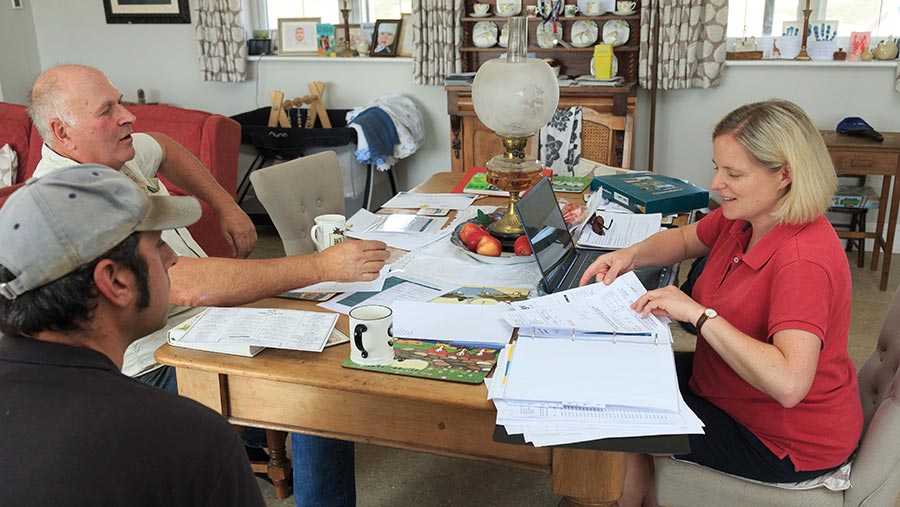6 tips for livestock farmers preparing for Red Tractor audit
 © Tim Scrivener
© Tim Scrivener Few farmers look forward to their Red Tractor inspection, and many bemoan the bureaucracy surrounding it – especially when it is one of several audits carried out annually to comply with one set of standards or another.
But if it must be done, better that it goes well. More than 60,000 Red Tractor inspections take place across the supply chain every year, and while most certificates are renewed, a small percentage of farmers come a cropper.
From April to July 2023, 1,055 (across all sectors) were suspended and 109 had their certificate withdrawn, according to Red Tractor’s figures.
Here, CXCS farm assurance consultant Rachel Matthews sets out six areas where farmers could tweak their preparation to reduce the risk of a repeat visit, or worse.
See also: Farmers Weekly Podcast Ep 153: Is it time to scrap the Red Tractor?
1. Tidiness
A farm is a place of work, so it does not have to be spotless or aesthetically pleasing. However, Red Tractor is a brand, and as with all brands, it wants its members to promote a positive impression to the public.
There will always be waste on a farm, but make sure is it stored tidily and away from public view.
Avoid stacking waste or other objects against buildings because this can harbour vermin and may be unsafe, as well as looking messy.
It is easy to get so used to seeing a pile of waste that you fail to really notice it anymore.
Before an inspection, check in corners and locations you might not normally look at, such as down the sides of sheds, or get a friend or neighbour not involved with the farm on a daily basis to walk or drive round with you.
It is amazing what a fresh pair of eyes will spot.
2. Medicine records and health plan
Incomplete paperwork is one of the most frequent “non-conformances”, with gaps in medicine usage and purchase records frequently seen.
Remember, your medicine purchase records can be your invoices – providing they contain all the necessary information.
Every farmer knows they need to keep on top of this paperwork, but time pressures often mean the task gets postponed or overlooked.
It is important to complete every field in these records, and withdrawal dates are sometimes missed.
Assessors are now paying more attention to “cascade withdrawals” (where medication is used off-label), so be mindful of situations where withdrawal periods automatically change to seven and 28 days for milk and meat, respectively.
Medicine cabinets must be locked, yet assessors often find them unlocked or insecure. Check that your lock works and is not rusty.
Check your livestock health plan is updated, and make sure you send your vet the parts they need to fill in early enough for them to be back with you in time for your audit.
3. Pest control
This is another area where improvements could be made in record-keeping.
Most farmers will have a map of the bait points on their farm, but they often miss the farm survey.
Checks for rodent activity must be recorded, capturing details such as where you have looked and what evidence of pests you may have found.
If there are pests, record how you plan to deal with them.
If that involves pesticides, you will need to justify why, and complete an environmental risk assessment, detailing what the risk factors are, such as the presence of birds of prey in the vicinity.
If you do have to use bait, make sure you have a record of where and when you put it down, when you checked it and whether it was taken.
4. Cattle lameness
Farmers often worry about assessors seeing lame cows, but assessors understand that animals get unwell and suffer from infections.
The important thing is whether the lameness is being managed.
- Do you know the cause of the lameness?
- Do you have a treatment plan in place? Assessors will often cross-reference this plan with your animal health plan and check for the treatment in your medicine records.
- Has the animal been seen by a foot trimmer?
- Are you using an isolation pen?
An assessor would not take issue with you following a vet’s advice, but would expect to see records of how and when that advice was implemented.
5. Time
Most audits take between two-and-a-half and three hours, so set aside at least this amount of time for the visit so you do not feel unduly rushed.
Preparation ahead is never wasted time. To help with this, you could go through the self-assessment checklist on the Red Tractor website, or contact your adviser or compliance specialist for a pre-audit check.
You can also upload your records to the Red Tractor portal ahead of the visit, so the auditor can see them beforehand.
Routine inspections are pre-booked by your auditor, often with one or two weeks’ notice.
Assessors should show some flexibility, particularly during busy times of year. Ultimately, though, they will be working to deadlines, and multiple cancelled audits could affect your membership.
6. Order
The audit process usually starts with a tour of the relevant areas of the farm, and then the assessor will come back into the office or house to look at the paperwork. It is important to let the assessor lead the audit.
There are specific areas they need to see: livestock; housing; transport; medicine storage; feed stores; manure heaps; slurry stores; chemical stores; and dairies and the parlour (if the farm is in the dairy scheme).
An audit can be a worrying time, but remember, the goal is not to trip you up – it is to point out good practice and recognise areas of improvement.
